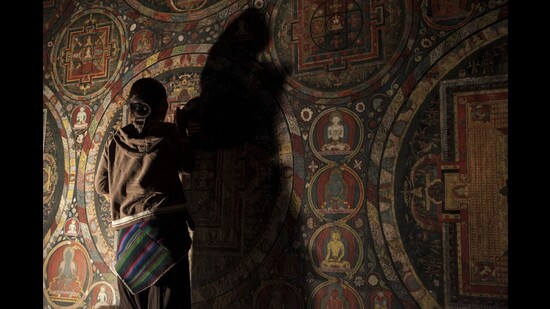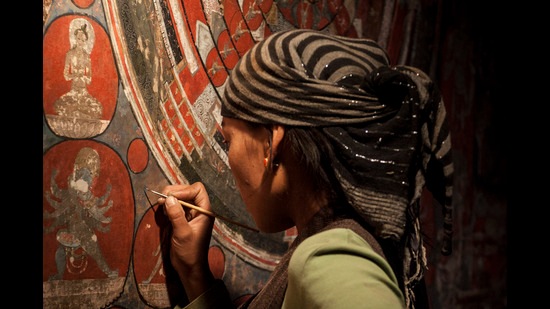Colouring outside the lines: Monasteries in Nepal are driving change
In the remote walled city of Lo Manthang, restoration work on ancient frescoes has sparked a cultural revolution. Women are now earning, tourists visiting.
A project to restore the art on ancient monastery walls is changing families, local economies and societies, in a remote corner of Nepal.

It all began when the walled city of Lo Manthang — formerly the capital of the independent kingdom of Mustang — opened its doors to foreigners, in the 1990s. This tiny corner of land had remained closed to the world from the 1300s, when it was founded, until about 30 years ago.
Even before it opened its borders, the non-profit American Himalayan Foundation had been working on educational and social welfare schemes in the region.
With the borders opened, the Foundation reached out to the Mustang royal family. Greater access meant that more could now be done. What should they focus on, as a priority, they asked? Help us restore the monasteries, the king responded.
A handful of these precious, once-revered two- and three-storey structures were crumbling in and around Lo Manthang. Some were 600 years old. All had interiors covered in intricate depictions of Buddhist lore. But the climate was changing, and the once-arid rocky Himalayan region was experiencing something it had no experience with: rain.
The humidity had caused the frescoes on the walls to flake and peel. In many cases, the monks had moved out; some monasteries had been reduced to serving as warehouses.
The first thing the foundation did was reach out to conservationist Rodolfo Luján-Lunsford, a professor at the Ars Labour Conservation Institute in Rome. Luján-Lunsford invited the Italian Luigi Fieni over to help steer the project. Fieni had worked on restoration projects across the region, and archived these efforts in his work as a photographer.
Fieni would join and then lead the Upper Mustang Cultural Heritage Project, as it came to be called. What started out as a two-year endeavour ended up lasting more than 20 years. Some of the monasteries are now home to monks again, and are drawing tourists.
No one who loves art or history could have walked away from these structures without trying to help, Fieni says. For him, this meant spending long months in a region with virtually no electricity and no telephone connections, particularly in the early years. “But I learnt that the less we have, the happier we are,” he says.
Invisible repairs
Now to the social and economic changes. Before work began, the king had asked that locals be employed in the project, to underline their stake in their heritage.
Luigi, along with two of his Italian colleagues and a local painter, Dawa Dhondup, trained teams of men to restore the walls and artwork. They taught them how to clean the walls of damp and dust, rebuild chipped segments and retouch the paint.
At first, only the men participated. Women weren’t traditionally allowed into the monasteries.
Then something interesting happened. In 2001, the main abbot of a large monastery here announced that the souls of the deities in the art works had temporarily left the monasteries. “The images weren’t deities anymore, but just images. The deities would return once the work was done, he said. The other conservators and I asked if this meant that women could now enter, and he said they could,” Fieni recalls.
Today, 30 of the 45 tribals at work on the monastery walls are women. Emboldened by their experiences, by the change they see around them, and by their earnings — which are nominal, but still exceedingly rare for women here to have — some are even opening up homestays to cater to the small but growing number of tourists, mainly trekkers, visiting the region.
Dolma Tsering, 44, now a mother of two, joined the restoration project in 2011. “Working on the holy art has given me a sense of joy and independence,” she says. “My children have seen me leave the house every day. They know that I shape and reinforce the walls.”

Tsering Wangmo, 45, has worked on the monasteries for 20 years. “The money I have earned has helped me expand my woollen-clothing business,” she says.
Fieni has since had his work permit rejected, in one of those tangles of bureaucracy that seems to befuddle everyone involved. But he retains his faith, especially in the women who have held the project together.
“Our mission, in restoring the structures, was to turn these religious buildings back into monasteries, not into museums, and this we have achieved,” he says. “Now, Lo Manthang may be undergoing a cultural renaissance of sorts. The project has had its ripple effects.”
Fieni has also documented the effort in a photobook titled Tibetan Mustang, released in August and co-authored with Amy Heller, with photographs by Kenneth Parker.
All Access.
One Subscription.
Get 360° coverage—from daily headlines
to 100 year archives.



HT App & Website







